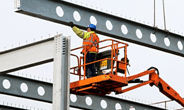Steel Markets

AGC: September Construction Jobs Up, But Labor Shortages Persist
Written by David Schollaert
October 23, 2022
Nearly two-thirds of US states added construction jobs month-on-month (MoM) in September. Most also boosted construction employment during the past twelve months, according to Associated General Contractors of America (AGC) figures.
![]() AGC said the job gains were welcome news even if significant labor shortages probably prevented an even bigger upswing in employment.
AGC said the job gains were welcome news even if significant labor shortages probably prevented an even bigger upswing in employment.
“While it is encouraging to see construction employment expanding in a majority of states, it is tempting to imagine how much higher those gains would have been if contractors could find enough workers to hire,” AGC CEO Stephen Sandherr said.
Citing a recent survey by the association, Sandherr said 91% of firms are having a hard time finding workers to hire.
Florida added the most construction jobs in September, a total of 6,900, up 1.2% MoM. The Sunshine State was followed by New York (4,200 jobs, +1.1%), Virginia (3,300 jobs, +1.6%), Michigan (3,200 jobs, +1.8%), and Ohio (2,100 jobs, +0.9%). North Dakota had the highest percentage increase, +4.6% MoM (1,300 jobs), followed by Kansas (+2.4%, 1,600 jobs), Connecticut (+2.1%, 1,300 jobs), and Wyoming (+1.9%, 400 jobs).
Among the 15 states and the District of Columbia that shed construction jobs in September, New Jersey lost the most, down -2,700 jobs or -1.7% MoM. Other states losing a high number of construction jobs included Texas (-2,600 jobs, -0.3%), Alabama (-2,500 jobs, -2.4%), and Arizona (-1,700 jobs, -0.9%).
Alabama had the highest monthly percentage decline in construction employment during the month, followed by Vermont (-2.0%, -300 jobs), New Jersey, and Oklahoma (-1.1%, -900 jobs). Three states had no change in their construction employment levels for the month.
On a year-on-year basis (YoY) through September, Florida added the most construction jobs (+8,900 jobs, 1.5%), followed by Utah (+4,700 jobs, 3.6%), Massachusetts (+4,700 jobs, 2.7%), and New York (+4,600 jobs, 1.2%). North Dakota had the highest rate of growth YoY, +7.2%, or 2,000 more jobs, followed by Utah, Connecticut, and West Virginia.
Over the past twelve months, the District of Columbia together with 18 states lost construction jobs. Texas lost the most construction jobs, down 2,900 or -0.4% YoY, followed by Louisiana (-1,600 jobs, -1.2%), South Carolina (-1,500 jobs, -1.5%), Maryland (-1,400 jobs, -0.9%), and Oklahoma (-1,400 jobs, -1.8%). Mississippi recorded the fastest rate of construction job losses for the year, -1.9% or 900 fewer jobs. It was followed by Oklahoma, South Carolina, and Wyoming.
Sandherr urged Congress and the Biden administration to boost funding for career and technical education programs, calling for measures to allow more people with construction skills to lawfully work as a short-term measure to relieve labor shortages.
“This industry needs more workers to help hard-hit communities rebuild, improve infrastructure, and modernize our energy and manufacturing sectors,” Sandherr said.
By David Schollaert, David@SteelMarketUpdate.com

David Schollaert
Read more from David SchollaertLatest in Steel Markets

CMC looks beyond Arizona micro-mill woes to long-term viability of construction mart
Despite the economic and geopolitical upheaval of the last five years, CMC President and CEO Peter Matt points out that the construction market has been an essential element of the way forward.

US importers face stricter rules under revamped S232 tariffs
“CBP expects full compliance from the trade community for accurate reporting and payment of the additional duties. CBP will take enforcement action on non-compliance," the agency said in a March 7 bulletin.

Steel exports rebound in January
US steel exports recovered to a five-month high in January after having fallen to a two-year low in December. This growth follows four consecutive months of declining exports.

Construction spending drops marginally in January
Construction spending edged down slightly in January, slipping for the first time in four months. The US Census Bureau estimated spending at a seasonally adjusted annual rate of $2,196 billion in January, down 0.2% from December’s downward revised rate. The January figure is 3.3% higher than a year ago. January’s result, despite the slight erosion, […]

HVAC equipment shipments slow in December but strong annually
Shipments of heating and cooling equipment in the US fell to an 11-month low in December, according to the latest data released by the Air-Conditioning, Heating, and Refrigeration Institute (AHRI).
